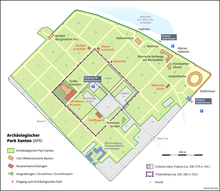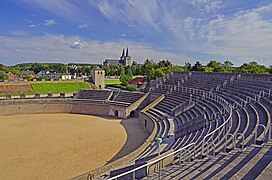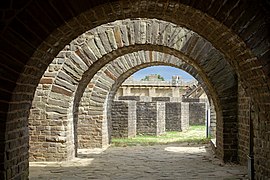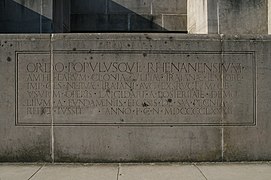Amphitheater of Colonia Ulpia Traiana

The amphitheater of Colonia Ulpia Traiana was a typical stone-built round theater that a larger city like the Roman Colonia Ulpia Traiana must have had in the second century AD. It was the largest event location in the ancient predecessor city of today's North Rhine-Westphalian Xanten , had an oval arena and could hold up to 10,000 people.
Purpose and location
Amphitheaters were among the characteristic structures of a Roman city and covered a wide range of leisure activities for its residents.
“Large public events such as the fights in the amphitheater and the chariot races in the circus were by far the most popular entertainment for large sections of the population. The great amphitheaters in Rome and the provinces were regularly filled to the last seat when people and animals fought to the death in the arena. Even emperors like Marc Aurel, who despised the gruesome demonstrations, felt compelled to fulfill their duty as the organizers of the 'Games'. "
Even before the Colonia Ulpia Traiana was founded , the amphitheater of Birten , built in the middle of the 1st century AD , was in close proximity to the Vetera legionary camp . Around the time the city of Colonia was founded around the year 100, an amphitheater was immediately laid out within the new city walls. At first it was just a wooden system on an earth wall. Only towards the end of the 2nd century was it replaced by a new building made entirely of stone. As usual for such facilities, the amphitheater was located on the outskirts of the settlement, namely in the very corner on the easternmost insula of the urban area. The area in the vicinity was not built on in order to enable the large numbers of visitors to enter the facility.
Excavation and reconstruction
The amphitheater had a diameter of 99 m in the longitudinal axis; the outer wall should have reached a height of more than 10 m. Hardly anything was left of the rising masonry due to stone robbery during the first excavations, but the foundations made of Grauwacke were still there.
Large areas of the CUT's amphitheater were already uncovered in the 1930s. In addition to the foundations of the masonry, traces of the wooden structures underneath the arena were also found. The documentation of the excavations at that time is unfortunately only incomplete. In the interior of the arena, the wooden cellar, which was uncovered at that time, has been uncovered again since spring 2018. In addition to other questions about the reconstruction of the findings, the aim is to clarify whether the wood residues uncovered during the excavations at that time were left behind in situ and whether the massive stone weights for the operation of elevators, which are mentioned in the documentation at that time, were returned to the filling of the old excavation areas on site . Martin Müller is in charge of the excavation .
After the excavation in the 1930s, the remaining findings were probably left in their place, with the exception of three Grauwacken, which were set up next to the complex. The rest of the foundation remained in place and served as the basis for the partial reconstruction of the structure in the Xanten Archaeological Park.
Statue of the Emperor Trajan in the reconstructed building
Usage today
Today there are regular events in the reconstructed amphitheater. International artists performed at the Xanten Summer Festival with operas, operettas and musicals until 2012. Rock greats also use the special charm and the good acoustics of the arena for open-air concerts.
The gladiator games at the great Roman festival "Swords, Bread and Games" in the APX are a special event . They are led by one of the leading historians in the field of gladiature and show, apart from the usual Hollywood clichés, but in a gripping and impressive way, how the different gladiators fought with which equipment and according to which rules. In addition, the “Roman Weekends” offer some dates in the summer when Roman gladiators demonstrate their true-to-original equipment and cross their blades for practice purposes.
The Roman Festival in 2018 brought a new attendance record with 26,000 visitors.
“The Roman Festival in Xanten is a great spectacle - with gladiator fights, equestrian squadrons and legionnaires' parades - but at the same time a serious and serious matter. It's about authenticity instead of a creative interpretation of the story, about true-to-original representations and the transfer of knowledge - after all, the APX is a museum. 'What is presented here must really be Roman', says Sebastian Held, who is himself an archaeologist and is responsible for public relations at the park. "
Web links
- Colonia Ulpia Traiana, Xanten (Germania Inferior). In: Amphi-Theatrum .
literature
- Ursula Heimberg , Anita Rieche : Colonia Ulpia Traiana. The Roman city. Planning, architecture, excavation. (= Guide and publications of the Xanten Archaeological Park. Number 18). Revised by Ursula Grote. Rheinland-Verlag on commission from Dr. Rudolf Habelt, Cologne / Bonn 1998, ISBN 3-7927-1725-5 , pp. 86-89.
- Martin Müller : The amphitheater. In: Martin Müller, Hans-Joachim Schalles , Norbert Zieling (eds.): Colonia Ulpia Traiana. Xanten and its surroundings in Roman times. (= History of the city of Xanten. Volume 1). Philipp von Zabern, Mainz 2008, ISBN 978-3-8053-3953-7 , pp. 361-371.
Individual evidence
- ↑ a b Description of the amphitheater on the APX website, accessed on September 12, 2018.
- ^ Excavation in the amphitheater 2018 , accessed on September 12, 2018.
- ↑ Robin Kunte: The Roman Festival in Xanten is celebrating a new visitor record . In: Neue Ruhr Zeitung . June 24, 2018, nrz.de , accessed on September 12, 2018.
Coordinates: 51 ° 40 ′ 2 " N , 6 ° 27 ′ 4.5" E







